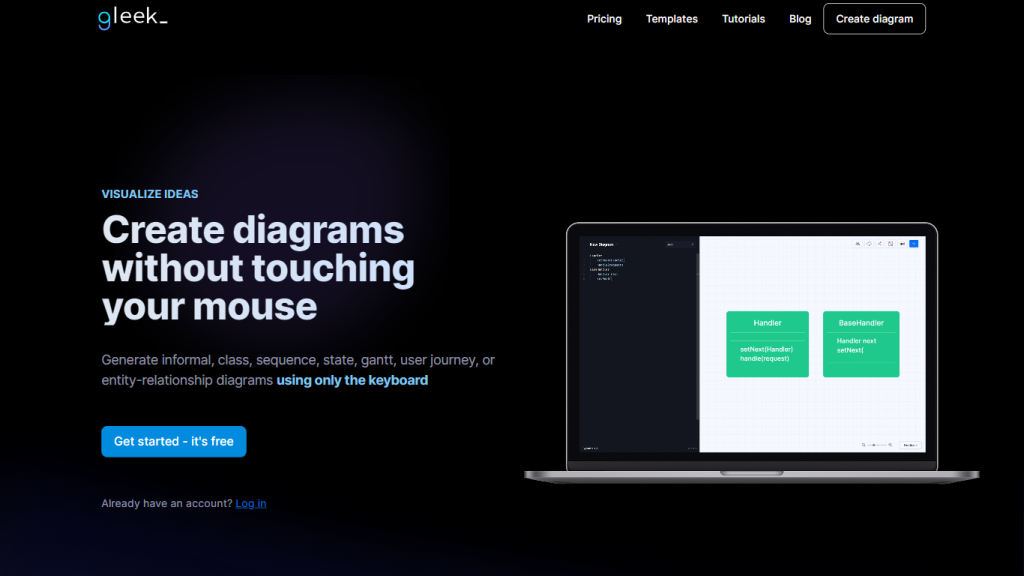What is Gleek?
Gleek is a Dia-like tool oriented at those developers who like the efficiency of using a keyboard over a mouse. It is different in the sense that any of these charts can be drawn by using nothing but a keyboard. Gleek helps to envision any complex idea or construction and is therefore useful for the software architecture, project planning, and structuring databases. Gleek enables all this and a lot more to be done much simpler. It uses intuitive syntax for flowcharts, UML diagrams, and many others. The interface is easy to use, has no minimum learning curve, and includes various other features to maximize user experience.
Gleek’s Key Features & Benefits
Rapid Diagramming: Focus on ideation and creating a diagram without using the mouse, which saves a lot of time and hassle.
Version Control: Because it deals with text descriptions and not binary files, versions of diagrams can be managed with much ease. This makes version control easier.
Live Collaboration: Teams can work together in real time to finish ideas for projects.
Diagram Export: Export and share diagrams in a host of formats to meet different needs or preferences.
Design Templates: Get started fast in common diagramming use cases and save time using pre-designed templates for users.
This makes Gleek a quite potent tool that may help developers enhance their productivity and collaboration levels and may simplify diagram creation.
Gleek Use Cases and Applications
There are a number of different uses of Gleek. Here are a few examples:
-
UML Diagram:
Creative and detailed UML diagrams can be made to conceptualize and communicate a software structure. -
Gantt Chart:
Efficiently manage and plan projects with the help of Gantt charts and user journey diagrams. -
Database Structuring:
One can give the database outlines for visualization and in designing schema.
Gleek will be particularly useful in industries like software development, information technology, and project management. For example, a development team might use Gleek to design the architecture of a new application so that all parties are clear about the scope and structure of the project.
How to Use Gleek
Getting started with Gleek is quite easy. Simply:
- Sign up for free at the Gleek website.
- Learn how to use the syntax created by Gleek from the tutorials and documentation.
- You can start drawing your diagram by just typing some text descriptions of it according to defined syntax rules.
- Put it into real-time collaboration by inviting team members to really contribute by live collaboration.
- Share and present your finished diagram, easily exported to your preferred format.
But to do this in the best way, leverage the design templates and further customization options to make the diagrams meet all your requirements. The user interface is designed to ensure the workflow goes on as smooth and efficient as possible.
How Gleek Works
Gleek works with a special syntax to transform text descriptions into a wide range of diagram types. It is fast and easy to learn, so even developers with minimal training can produce detailed diagrams. Since technology has evolvingly been endorsed, it supports real-time collaboration and version control, making it possible for teams to work efficiently together and easily track their diagram versions.
Pros and Cons of Gleek
Every tool has some benefits and some probable drawbacks. Here are the pros and cons of Gleek:
Pros:
- Effective diagramming by keyboard input
- Full version control due to text-based management
- Real-time collaboration for perfect teamwork
- Multiple export options to share your work flexibly
- Easy to use with a very small learning curve
Cons:
- Not ideal for people who like working with graphical interfaces
- Limited only to the type of diagrams its syntax can support
User feedback generally describes Gleek as efficient and easy to use. The majority of users love Gleek’s keyboard-driven approach along with features concerning collaboration.
Conclusion on Gleek
Gleek, in short, is a powerful diagramming tool tailored to developers who are inclined to keyboard inputs. Core features of Gleek encompass fast diagramming, version control, and live collaboration. Thereby, it is undoubtedly the best choice for planning software architecture, project planning, and structuring of databases. It is not perfect, just as many of its users wish for it to be, and especially people that like graphical interfaces. The overall pros outweigh the flaws in its target area. Besides, the future is likely to bring a lot of improvement to enhance the user experience further.
Frequently Asked Questions About Gleek
What is Gleek?
Gleek is a developer-friendly diagram maker, which enables creating any kind of diagram you want, all from the comfort of your keyboard.
What diagrams can I draw with Gleek?
Gleek supports informal diagram, class diagram, sequence diagram, state diagram, Gantt, user journey diagram, entity relationship diagram.
How does Gleek work?
Gleek enables one to easily annotate their description text into a text-based diagram through its own syntax.
Does Gleek support the versioning of diagrams?
Yes, Gleek has version control because you need to manage your diagrams with the textual descriptions.
Is Gleek free, and how do I get started?
Gleek is free to start. You will be able to start diagramming quickly after signing up.










